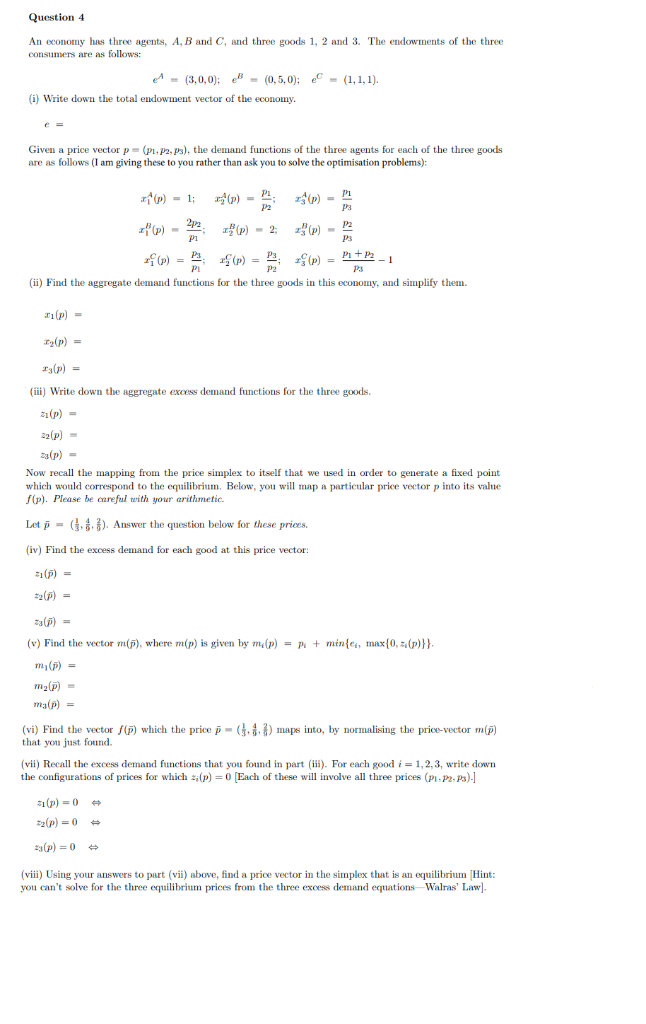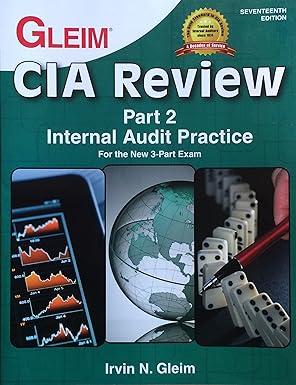Answered step by step
Verified Expert Solution
Question
1 Approved Answer
SOLVE FOR PART V, VI, VII AND VIII only. Previous parts have been solved. Question 4 and 3. The endowments of the three An economy

SOLVE FOR PART V, VI, VII AND VIII only. Previous parts have been solved.
Question 4 and 3. The endowments of the three An economy has three agents, A. B and C. and three goods 1. follows: consumers are eA(3,0,0); e=(0,5,0): e=(1,1,1). (i) Write down the total endowment vector of the economy. e = Given a price vector p (p.p2. Pa), the demand functions of the three agents for each of the three goods follows (I am giving these to you rather than ask you to solve the optimisation problems): are 2p #(p)-2 Ps (d) (d) (ii) Find the aggregate demand functions for the three goods in this economy, and simplify them. (p (p)= r(p) (ii Write down the aggregate excess demand functions for the three goods. 2(p) 22(p) 2(p) Now recall the mapping from the price simplex to itself that we used in order to generate a fixed point which would correspond to the equilibrium. Below, you will map f(p). Please be careful with your arithmetic. particular price vector into its value Let p( ). Answer the question below for these prices. (iv) Find the excess demand for each good at this price vector: a(p) (v) Find the vector m(p), where m(p) is given by m(p) = p + minfe, max(0,(p)}} m(P) m2 ma(p) (vi) Find the vector f(p) which the price p( ) maps into, by normalising the price-vector m(p that you just found. (vii) Recall the excess demand functions that you found in part (iii). For each good i,2,3, write down the configurations of prices for which (p) 0 Each of these will involve all three prices (p.pps)-1 (p) 0 2(p)=0 2a(p)= 0 orium Hint: part (vii) aboe, find a price vector in the simph an't solve for the three euilibrim prices from tbe three excess demand emation Walras Lawl (viii that is Question 4 and 3. The endowments of the three An economy has three agents, A. B and C. and three goods 1. follows: consumers are eA(3,0,0); e=(0,5,0): e=(1,1,1). (i) Write down the total endowment vector of the economy. e = Given a price vector p (p.p2. Pa), the demand functions of the three agents for each of the three goods follows (I am giving these to you rather than ask you to solve the optimisation problems): are 2p #(p)-2 Ps (d) (d) (ii) Find the aggregate demand functions for the three goods in this economy, and simplify them. (p (p)= r(p) (ii Write down the aggregate excess demand functions for the three goods. 2(p) 22(p) 2(p) Now recall the mapping from the price simplex to itself that we used in order to generate a fixed point which would correspond to the equilibrium. Below, you will map f(p). Please be careful with your arithmetic. particular price vector into its value Let p( ). Answer the question below for these prices. (iv) Find the excess demand for each good at this price vector: a(p) (v) Find the vector m(p), where m(p) is given by m(p) = p + minfe, max(0,(p)}} m(P) m2 ma(p) (vi) Find the vector f(p) which the price p( ) maps into, by normalising the price-vector m(p that you just found. (vii) Recall the excess demand functions that you found in part (iii). For each good i,2,3, write down the configurations of prices for which (p) 0 Each of these will involve all three prices (p.pps)-1 (p) 0 2(p)=0 2a(p)= 0 orium Hint: part (vii) aboe, find a price vector in the simph an't solve for the three euilibrim prices from tbe three excess demand emation Walras Lawl (viii that isStep by Step Solution
There are 3 Steps involved in it
Step: 1

Get Instant Access to Expert-Tailored Solutions
See step-by-step solutions with expert insights and AI powered tools for academic success
Step: 2

Step: 3

Ace Your Homework with AI
Get the answers you need in no time with our AI-driven, step-by-step assistance
Get Started


